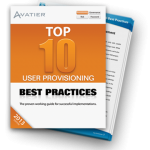There’s a significant push in the medical industry for creating electronic medical records and for good reason. When there’s a user provisioning solution for integrating and connecting systems while securing access for the right people to obtain a patient’s records, health care practitioners can provide a better care experience. And when records are digital, providers improve operational efficiency. But how do you balance these advantages while protecting patient privacy?
In an April 2013 computing.co.uk article titled “NHS Must Tackle Data Sharing Before Patient Information Goes Paperless,” Sooraj Shah highlights the importance of establishing user provisioning protocols before migrating to digital records. When asked about user provisioning, Dr. Jonathan Richardson, Clinical Director of Informatics at the Northumberland, Tyne and Ware NHS Foundation Trust states, “If you can’t get it right on paper, you won’t get it right on an electronic system, so you need to work it out before it goes on an electronic system.”
Dr. Richardson is absolutely correct in that the establishment of comprehensive security safeguards is essential prior to migrating paper records onto an electronic system. At Avatier, we recommend that our clients fully flesh out and validate their permission protocols for individuals and groups before transferring identity access privileges to an automated solution.
By establishing permissions configurations in advance, health care providers are in a much better position to maximize the effectiveness of their user access provisioning solution. When properly designed, the permissions configuration provides both the flexibility required to achieve streamlined operations through automation and self-service while enforcing solid security protocols required to safeguard patient privacy.
With all the staff members and medical providers’ information access complexities to information needed for their job, it’s highly beneficial to think through all possible permeations of access management needs prior to constructing the architecture of the user provisioning solution. Because once the structure is in place, automation handles the rest.
According to Jeremy Hunt, the Secretary for State Health, the NHS plans to be paperless by 2018 to both save money and streamline services. That’s a tall order, but achievable with the right access management software. With automated user provisioning workflow tools, health care organizations of any size can establish and automate user provisioning protocols and fully safeguard patient privacy.
Automated user provisioning provides a win-win. Health care organizations that leverage access management software are able to control who in their organization can see what based on preset permissions, thereby, ensuring that personal information isn’t inadvertently disseminated and when it does happen someone is held accountable. The right access management software also builds in enough flexibility for organizations to modify individual and group permissions at a granular level in real time, empowering staff members to do their jobs effectively as circumstances dictate.
At the end of the day, it’s all about better care. When health care providers achieve balance between protecting privacy and leveraging centralized electronic records, they achieve valuable benefits around cost savings, operational efficiency and reduced information security risks. But even more compelling, the patient is better served — that is what’s most important.
User provisioning and Password Reset Access Controls:
Automated user provisioning is a priority for health care IT that support hospitals and medical services. HIPAA medical record privacy, access certification audits, and continuously changing business users, medical staff, doctors’ offices, clinics and pharmacies require access to multiple systems along with streamlined user provisioning.
 Get the Top 10 User Provisioning Best Practices Workbook
Get the Top 10 User Provisioning Best Practices Workbook
Enable user provisioning software rapid planning, strategic decision-making, and technology innovation. Jump start your user provisioning and identity management initiative. Learn from IT security experts and address the challenges that derail projects.




